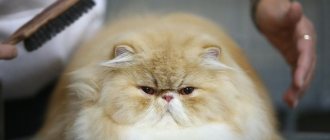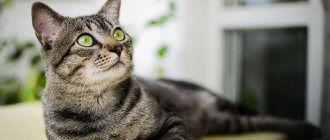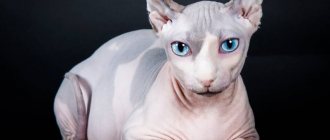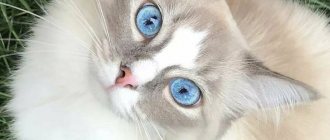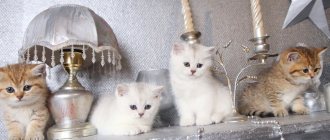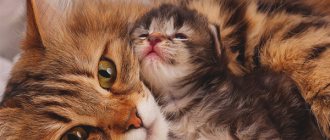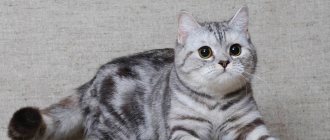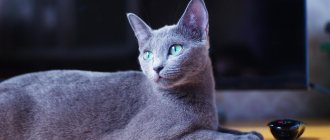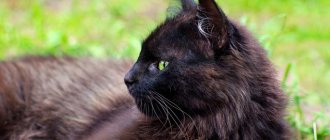Basic nutrition rules
When creating a menu and diet for a blue cat, the owner should pay attention to the advice of veterinarians who will help do it correctly:
- The diet must contain arginine, an amino acid found in animal proteins. For good reproductive health, as well as for the nervous system, taurine is also necessary - an aminosulfonic acid present in fish, lamb, beef and other products. In addition, arachidonic acid, obtained from animal fats and necessary to replenish the pet’s energy reserves, is important for the cat’s body.
- The nutritional schedule must be strictly followed.
- Pets should eat healthy food, but in moderation, since Russian Blues are prone to obesity. The optimal rate is 150-210 g, if the animal’s weight does not exceed 4-5 kg. Spayed and neutered cats should consume slightly less - up to 130 g per day. If there are no problems with excess weight, you can leave the previous norm.
- The Blue Russian cat loses its natural color and becomes red if its diet contains too many foods high in iodine and copper. Therefore, legumes, seaweed, shellfish, and liver should be excluded from the menu.
- Whole milk and fatty fish have a negative effect on a cat's digestive system. These foods should be completely excluded from the diet.
Kitten Feeding Basics
The kitten's body is quite vulnerable, so the best nutrition during the first weeks of its life is mother's milk. About 30-40 days after birth, milk alone becomes insufficient for the kitten. At this age, it is recommended to introduce the first feedings.
Babies, unlike adult cats, are allowed to give slightly warmed (not higher than 40℃) cream or pasteurized milk with a fat content of 2.6-3.8%. Fermented milk products such as grated cheese and crushed cottage cheese are allowed. Of course, they should not contain any spices or artificial additives.
Porridge can be given from approximately the second month. It is important that they are liquid enough so that the kitten’s body can easily absorb them. As for meat, turkey, chicken, rabbit, and beef are best for your baby. It shouldn't be raw. The meat must be boiled and minced as much as possible.
A two-month-old Russian Blue kitten should be given egg yolk in its diet, but no white. Ready-made canned food intended for kittens can replace the meat part. From 7-8 weeks, the kitten can try its first dry food. Of course, it will be quite difficult for an animal to chew it on its own, so it is worth pre-soaking the granules in clean water.
When the kitten’s body gets used to these products, you can gradually add boiled vegetables, kefir and canned food. A kitten under 2 months of age should eat 4 times a day. After 3 months, three meals are enough, and after a year, two.
Natural food for adult cats
If the owner decides to feed his pet “natural” food, then the menu should include the following products:
- Meat . All purebred representatives are big meat lovers, but it is recommended to completely exclude pork from their diet. Poultry meat is more suitable - turkey, chicken. Beef and veal can complement this list. Most vitamins are found in chilled raw meat. However, sometimes it can be boiled and stewed.
- Fish . Sea varieties are best suited. It must first be boiled and pitted. Frequency – once every 10 days.
- Offal . Can be used several times a week. Liver, heart, lungs, kidneys, tripe are useful for the cat’s body. It is better to give them raw.
- Seafood . From this category, only shrimp and shellfish are allowed. They must be boiled first. You should not give these products to your animal more than once a week.
- Dairy . Pasteurized milk with a fat content of up to 1.5%, sour cream with a fat content of up to 20%, fermented baked milk, kefir and natural (without additives) yoghurts are allowed.
- Eggs . Chicken eggs can only be given boiled, because raw eggs contain avidin, which destroys vitamin H. Quail eggs can be given both raw and boiled. Eggs are not given to a cat more than once every 10 days.
- Cereal products . Almost all varieties of grains, except sprouted ones, can be included in the diet. Pasta and baked goods do not provide any particular benefit to the animal, so they are not necessary.
- Vegetables. Products of plant origin are poorly absorbed by the Russian Blue cat's body. However, you should not completely exclude them from the diet. It is useful to give them to prevent vitamin deficiency. Zucchini, carrots, beets, and canned corn are suitable. The optimal volume of vegetables should be calculated as follows: 5 g of vegetables per 1 kg of cat weight.
It is forbidden to feed the Russian Blue cat sweets, confectionery, fruits, or dishes with spices.
Brief characteristics of the breed
How are Russian Blues different from the British? | They are completely different, representatives have different sizes, builds, weights, and coat textures. Russian blues have green eyes, while animals of the British breed of a similar color have copper or amber eyes. The similarity is only in the color of the coat, but according to the British standard, almost any color is allowed. |
Where to buy a kitten with a pedigree? | In the nursery, which must be a member of the club. Information about them can be obtained at exhibitions, specialized printed publications, and on the Internet. |
You need a purebred kitten, how not to make a mistake with your choice? | There are 5 conditions that guarantee the quality of the breed:
|
Is a crooked tail tip a defect? | Yes it is. Such animals are not allowed for breeding. |
The Russian Blue cat's fur on his chest and inner surfaces of his paws has become a little brown. Why might this happen? | The fur may turn brown if the cat sleeps on the radiator. Put a rug there for him. This will prevent direct contact with the battery. The fur acquires a darkish tint from exposure to direct rays of the sun, excess copper and iron in the diet. Adjust the diet, protect the cat from direct contact with the sun's rays. Subsequently, the wool will become the same. |
Is it possible to train a Russian Blue to a leash? | Yes, sure. It is better to buy a harness, it does not restrict movement. A cat can get out of a collar quite quickly. A little indoor training is needed to get her used to the restrictions on her freedom. In the future, you can take long walks with your cat. |
Why does a three-month-old kitten often hiccup after eating? Diet: canned food and dry food. | Watch the kitten eat. If he is wolfing down food, he may not be getting enough because the portions are too small. During such hasty swallowing, air enters the stomach, and then the kitten hiccups. In this case, feed the animal more often or provide constant access to dry food and water. Conversely, a kitten may hiccup due to overeating. In this case, you need to slightly reduce the portions and be sure to check your pet for worms. |
How long do Russian Blue cats live? | On average, 10-18 liters. This depends on the quality of nutrition and care, and external environmental factors. |
Advantages:
- Smart, easy to learn.
- Very flexible and obedient.
- There are no negative traits, for example, meanness (a cat never spoils things).
- They become attached to their owner, but tolerate loneliness well.
- Get along well with children and other pets.
- They are independent, entertain themselves if household members are busy with business.
- Unpretentious in care.
- Have good health. They have excellent immunity, no genetic diseases have been identified.
- They live long. If you provide quality nutrition and proper care, your cat can live 18 years.
- The fur does not cause allergies.
- Cats of this breed do not mark territory.
Flaws:
- They are very picky about the cleanliness of the toilet and bowls: they will not go into a dirty tray and will not eat and the dishes are not clean enough.
- They are distrustful of strangers, show shyness and wariness.
- They have a quiet voice, which makes it difficult to determine when they are in heat.
- Excessive mobility and restlessness can become a disadvantage for those who love a calm, measured life.
- Dependent on the psychological atmosphere in the house. If it is unfavorable (scandals, swearing), the pet will become apathetic and lethargic.
| Body |
|
| Head |
|
| Ears |
|
| Eyes |
|
| Limbs |
|
| Tail | long, with a slightly rounded tip |
| Wool |
|
| Color |
|
| Flaws |
|
The origins of this breed are very controversial. According to one version, English sailors standing with their ship in Arkhangelsk noticed an unusually beautiful cat in the vicinity of the city and took it on board with them. According to another version, the animals, on the contrary, escaped from an English ship and took root in the northern port.
There is no information that would confirm either of these versions. The subsequent development of the breed was carried out in England. Since 1893, breeding began with animals probably brought from Russia. In 1935, the first standard was registered, which marked the official appearance of the breed.
The First World War put the animal in danger of extinction. To preserve the breed, the British crossed it with Siamese cats - their characteristics can still appear in modern Russian Blues today.
The restoration of the breed continued only in the 20th century, already by the Americans, and only in the 70s did the Russian blue cat regain its original appearance, and in the 80s it returned to Russia again.
The following description of the standards suits the appearance of the Russian Blue cat:
- Adult weight: 3-7 kg.
- The body is strong, muscular, long. The body shape is elegant.
- The paws are thin and long.
- The tail is long, maintaining proportions to the body.
- The head is wedge-shaped with a flat and long profile, the nose is without a break.
- The ears are set wide apart, wide at the base and tapering towards the tips, long.
- The eyes are round, green, and spaced apart.
- The coat feels plush to the touch, is soft, thick, and short. The coat has a double structure and does not adhere to the body.
The long-haired variation of the cat does not meet the standards; it belongs to a separate rare breed - the Nibelung.
We suggest you read: Instructions for removing worms from a kitten. Prevention of worms in cats is the main activity of every breeder Treatment of a kitten for worms
The character of the Russian Blue is somewhat stubborn: it will obey only one owner, while preferring independence. However, wandering on the street is not at all typical for her - she is truly a pet.
This breed behaves cautiously and modestly with guests in the house; it will not be the first to make contact. With its owner, the Russian Blue cat is open and loyal, does not bother him, and is never intrusive. If you already have other animals at home, even small ones like a degu or a chinchilla, rest assured that the new pet will get along well with them.
If you read the reviews of the owners, many note the high intelligence of their pets: cats very quickly begin to understand the gestures and words of the owner. And when playing with a person, they release their claws, playing exclusively with their soft paws.
Meals on special occasions
In some cases, Russian Blue cats need to adjust their diet:
- Pregnancy . Naturally, during the gestation period, the future mother cat should eat as balanced and high-quality food as possible. This does not mean at all that she needs to be fed meat or cottage cheese. From the second half of pregnancy, the volume of food should be increased by about 50%, but this is individual. Overfeeding a pregnant cat promotes active growth of kittens in the womb, which in turn causes complications during delivery.
- Castration, sterilization . Changes in hormonal levels will go smoothly if the owner carefully monitors the animal’s diet. Drinking plenty of fluids is one of the main conditions. Water should always be fresh and clean. If the cat refuses to drink, his food should be “wet”. The best products in this case will be offal, sour cream, cottage cheese, and porridge. Fish is prohibited for sterilized cats.
- Old age. Just like humans, an old cat's digestive system is unable to digest food well. It is important that the diet of an aging animal contains as many vitamins and proteins as possible. It is better to reheat food before serving. It is also necessary to give your pet water. If the cat refuses water, it is worth adding a small amount of flavoring liquids, for example, with the smell of fish. If your pet is on commercial diets, you should purchase premium food according to its age.
What is the character of Russian Blue cats?
Animals of this breed are smart, peace-loving and calm, but at the same time they are not averse to sometimes frolicking and chasing real or toy prey.
Such pets love human company and willingly spend time with the whole family, participating in everything that happens and willingly basking in their arms. They cannot be called intrusive: persistently demanding attention is not at all in the nature of the breed. They usually don't have a loud voice either. As for strangers, Russian Blues treat them rather with caution and suspicion.
These cats tolerate short-term loneliness quite calmly and always find something to do with themselves. At the same time, they are very neat and never cause chaos in the apartment, even if they actively explore all the cabinets, shelves and other high surfaces. And the return of family members is always welcomed.
We suggest you read: How to train a cat to sleep at night and in the morning?
Affectionate animals enjoy spending time in the company of younger family members. Russian Blues are not inclined to show aggression and are usually in no hurry to use their claws, even if the kids are literally cuddling them. Scratching can only be expected from kittens who participate in games with all the enthusiasm.
Pets of this breed live quietly under the same roof with cats and dogs and do not show hostility towards them. Of course, when a new pet appears in the house, some difficulties may arise, but over time the animals will get used to each other and the situation will improve.

